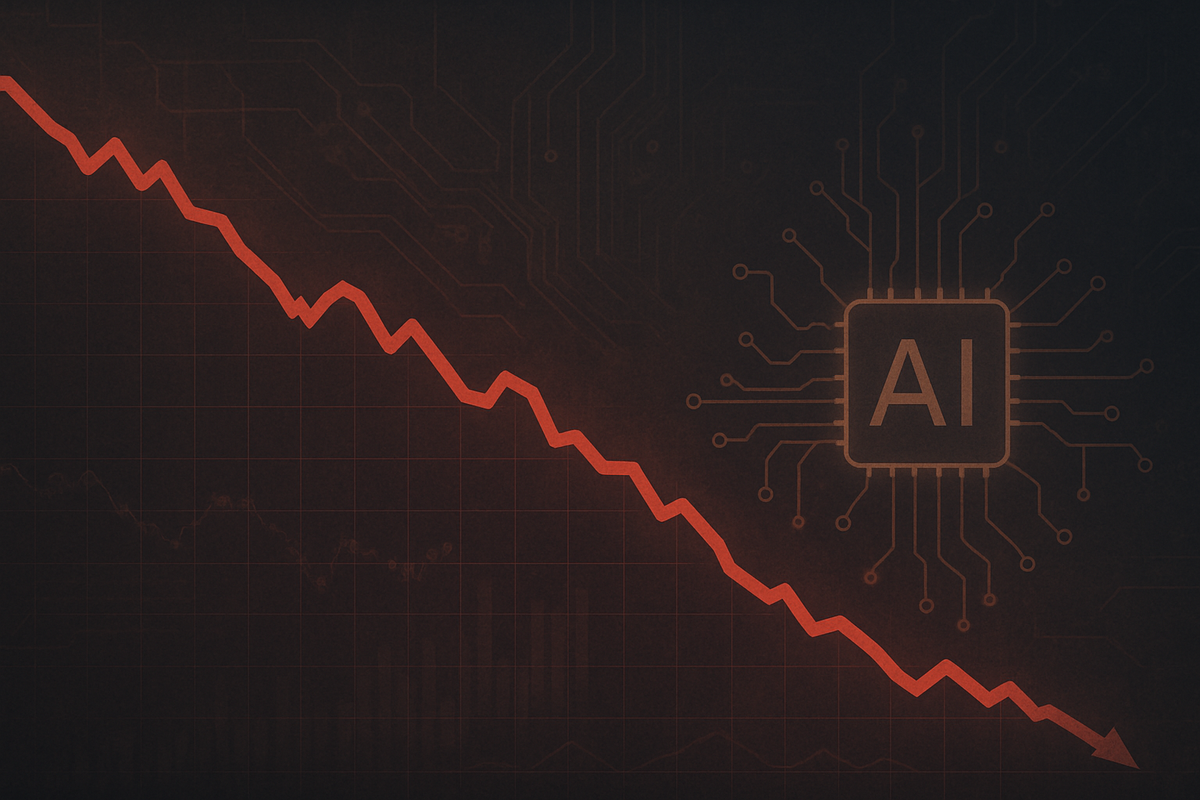
The S&P 500 Technology sector experienced a significant downturn today, October 7, 2025, acting as a major drag on the broader market and abruptly ending what had been a robust winning streak for major indices. This sharp reversal was largely catalyzed by a notable decline in shares of software giant Oracle (NYSE: ORCL) and mounting investor apprehension regarding the sustainability and immediate profitability of the much-hyped artificial intelligence (AI) trade. The sell-off signals a potential re-evaluation of high-flying tech valuations and casts a shadow over the market's recent exuberance.
The sudden shift in sentiment underscores a growing concern that the rapid ascent of AI-driven stocks may have outpaced tangible commercial returns, prompting investors to pull back from riskier growth assets. As technology stocks, particularly those heavily exposed to AI, faced intense selling pressure, the ripple effects were felt across the market, leading to a broader retreat and compelling analysts to question the immediate future of the technology-led rally.
Oracle's Plunge Triggers Broader Tech Retreat
The day's market drama unfolded with a sharp decline in Oracle (NYSE: ORCL) shares, which plummeted following reports suggesting lower-than-expected margins from its burgeoning AI-related cloud business. While details remain sparse, initial analyses point to a significant "monetization gap," where substantial investments in AI infrastructure are not yet translating into the anticipated profit margins. This news acted as a potent catalyst, igniting fears that other companies heavily reliant on AI for future growth might face similar profitability challenges, leading to a widespread re-evaluation of their valuations.
The immediate reaction was a broad sell-off across the S&P 500 Technology sector, with the sector index registering its largest single-day drop in months. Key players in the semiconductor space, such as Nvidia (NASDAQ: NVDA) and Advanced Micro Devices (NASDAQ: AMD), which have been at the forefront of the AI boom, also saw their shares decline significantly as investors questioned the demand outlook for AI chips if the commercialization benefits prove elusive. The timeline leading up to this moment has been characterized by an almost uninterrupted surge in AI-related stocks, fueled by speculative enthusiasm and massive capital expenditure announcements. However, whispers of overvaluation and a potential "AI bubble" have been growing louder in recent weeks, with today's events bringing those concerns to the forefront.
Initial market reactions were swift and decisive, with trading volumes surging as investors rushed to de-risk their portfolios. The Nasdaq Composite, heavily weighted towards technology, also experienced a substantial decline, mirroring the tech sector's woes. The sudden shift in momentum caught many off guard, particularly those who had ridden the wave of optimism surrounding generative AI's transformative potential. Analysts are now scrambling to adjust their models and outlooks, with many pointing to the potential for a more sustained period of correction as the market grapples with the reality of AI's implementation challenges and slower-than-expected returns.
Winners and Losers in a Shifting Landscape
The cooling of the AI trade and the tech sector's downturn are poised to create a distinct divide between market winners and losers. Companies that have seen their valuations soar primarily on AI potential, rather than established profitability or diversified revenue streams, are likely to face continued headwinds. This includes many specialized AI software firms and certain hardware manufacturers whose growth narratives are almost entirely tethered to the AI super cycle. Their ability to demonstrate clear, near-term profitability from their AI ventures will be crucial in stemming further declines. Conversely, companies with strong balance sheets, diversified product portfolios, and less direct exposure to the most speculative aspects of the AI trade may prove more resilient.
Traditional value stocks and companies in more defensive sectors, such as consumer staples (e.g., Procter & Gamble, NYSE: PG) and utilities (e.g., NextEra Energy, NYSE: NEE), could see increased investor interest as capital shifts away from riskier growth assets. Furthermore, established technology companies that can demonstrate tangible, immediate benefits from AI integration into existing profitable products, rather than relying on future AI-specific revenue, might fare better. The downturn could also benefit companies specializing in AI cost optimization or those providing foundational, less speculative cloud infrastructure that isn't solely reliant on cutting-edge AI deployments.
The event might also put pressure on venture capital funding for early-stage AI startups, as investors become more discerning and demand clearer paths to profitability. Companies that have recently gone public or are planning IPOs with AI as their primary growth driver could face a much tougher market reception. Those that can adapt quickly, pivot their strategies to focus on proven revenue models, or offer compelling valuations based on current fundamentals rather than future hype, will be better positioned to navigate this more challenging environment.
Wider Significance: A Reality Check for the AI Super Cycle
This significant downturn in the S&P 500 Technology sector, spearheaded by Oracle's performance and broader AI concerns, represents more than just a single day's market movement; it signifies a crucial reality check for the much-vaunted AI super cycle. For months, the narrative has been one of exponential growth and limitless potential, often leading to valuations that detached from traditional financial metrics. This event signals that the market is entering the "Trough of Disillusionment," a phase described by Gartner's Hype Cycle, where the initial euphoria gives way to a more sober assessment of a technology's practical challenges and slower-than-anticipated returns.
The ripple effects are likely to extend beyond the tech sector, potentially influencing capital allocation across the entire economy. Venture capitalists and corporate strategists may become more cautious, scrutinizing AI investments with a sharper eye for demonstrable ROI rather than speculative growth. This could lead to a slowdown in certain types of innovation if funding dries up for projects without clear commercial pathways. Regulatory bodies might also begin to pay closer attention to the financial stability of highly leveraged tech firms and the potential for systemic risk if widespread AI-driven investment falters, though immediate policy implications are unlikely.
Historically, periods of intense technological hype, such as the dot-com bubble of the late 1990s, have been followed by significant corrections when the commercialization of new technologies failed to meet inflated expectations. While the underlying technology of AI is undeniably transformative, today's events serve as a potent reminder that market cycles, driven by investor sentiment and profitability concerns, remain a powerful force. This correction could be a healthy recalibration, forcing companies to focus on sustainable business models rather than relying solely on speculative growth narratives.
What Comes Next: A Path Towards Sustainable Growth?
In the short term, the market is likely to experience continued volatility as investors digest today's news and re-evaluate their positions in AI-exposed stocks. We could see further capital rotation out of high-growth tech into more defensive sectors, at least until clearer signs of AI profitability emerge. Companies heavily invested in AI infrastructure and development will face increased pressure to demonstrate tangible returns on these investments, potentially leading to revised earnings forecasts and more conservative outlooks. The coming weeks will be critical as earnings season approaches, with every tech company's commentary on AI integration and monetization being scrutinized.
Looking further ahead, this cooling period could pave the way for a more sustainable and mature phase of AI development and adoption. The market correction might encourage strategic pivots towards practical applications of AI that solve immediate business problems and generate clear revenue, rather than chasing speculative, futuristic concepts. This could lead to a focus on niche AI solutions, enterprise applications with proven ROI, and improvements in operational efficiency through AI, rather than purely generative AI endeavors. Market opportunities may emerge for companies that can effectively leverage AI to cut costs, enhance existing products, or expand into new, underserved markets with a clear value proposition.
Potential scenarios include a prolonged period of consolidation within the tech sector, where stronger, more fundamentally sound companies acquire struggling AI startups or absorb their technologies. Alternatively, if economic conditions remain robust and companies successfully demonstrate AI's value, this downturn could be a temporary correction before a more measured, growth-driven rally resumes. Investors should watch for corporate earnings calls, management guidance on AI strategy, and any shifts in capital expenditure plans, as these will provide crucial insights into the industry's direction.
Navigating the New Tech Landscape
Today's sharp decline in the S&P 500 Technology sector, driven by Oracle's underperformance and a broader re-evaluation of the AI trade, marks a pivotal moment for the financial markets. The snapped winning streak serves as a potent reminder that even the most revolutionary technologies are subject to market cycles and the fundamental demands of profitability. The key takeaway is that while AI's long-term transformative potential remains undeniable, the market is now demanding a clearer, more immediate path to commercialization and tangible returns on the massive investments being poured into the sector.
Moving forward, the market will likely differentiate more sharply between companies that are genuinely leveraging AI for sustainable growth and those whose valuations are built on speculative hype. Investors should focus on companies with strong fundamentals, diversified revenue streams, and a clear strategy for monetizing their AI initiatives. The era of "growth at any cost" for AI may be giving way to a more disciplined approach focused on value creation.
In the coming months, investors should closely monitor corporate earnings reports for any signs of improved AI profitability, track capital expenditure trends in the tech sector, and observe shifts in investor sentiment. The ability of companies to adapt their AI strategies, demonstrate concrete ROI, and navigate a more discerning market will ultimately determine their success. This recalibration, while painful in the short term, could ultimately lead to a healthier, more robust technology sector built on sustainable innovation rather than speculative fervor.
This content is intended for informational purposes only and is not financial advice.



